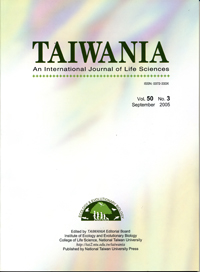Research Paper
Dynamics of Ultrastructural Characters of Drosophyllum lusitanicum Link (Droseraceae) Digestive Glands During Maturation and After Stimulation
Andrey E. Vassilyev
Published on: September 2005
Page: 167 - 182
DOI: 10.6165/tai.2005.50(3).167
Abstract
A quantitative investigation was conducted on the endomembrane system of the secretory cells of Drosophyllum lusitanicum Link digestive glands exporting acid hydrolases. The surface density of rough endoplasmic reticulum (RER) membranes as well as the number of Golgi stacks, clathrin-coated vesicles (CCVs) and their smooth derivatives increased progressively with the gland maturation. On average secretory cells of the fully mature unstimulated gland, each contained RER with a surface area of 17500 µm2 and 16000 small vesicles (including CCVs of 81 nm average diameter and smooth vesicles as the derivatives of CCVs which average 46 nm). One hour after stimulation imitating prey capture, the surface density of RER, the number of Golgi stacks and 'protein' vesicles all increased greatly. The data obtained indicate that smooth vesicular derivatives of CCVs are involved in the secretion of digestive enzymes. Hydrolase secretion started in the immature glands and continued in the mature stage irrespective of whether or not an insect was actually captured. Stimulation resulting in the release of digestive fluid on the surface of the leaf by the digestive glands appeared to be accompanied by a significant increase in the rate of hydrolase synthesis and secretion. In addition to protein vesicles, two other types of larger secretory Golgi vesicles were produced: granular-fibrillar ones (~ 105 nm in diameter that were confined to cells at the meristem stage), and loosely-fibrillar vesicles (~ 250 nm in diameter that occurred only at the stage of wall ingrowth deposition). Models are proposed that depict digestive gland cell functioning both before and after stimulation.
中文摘要
本研究針對露葉毛氈苔Drosophyllum lusitanicum Link (Droseraceae)分泌酸性水解酶之消化性毛茸的分泌細胞的內膜系統加以量化的探討。分泌毛茸之細胞的粗內質網膜系表面的密度,以及高基氏體、clathrin 被膜小囊胞 (CCVs)與其衍生的平滑小囊胞的個數,均隨著分泌毛茸的成熟而逐漸增加,在完全成熟而未刺激之毛茸的每一分泌細胞,含有之粗內質網膜系的平均表面積為17500 µm2以及16000 個小囊胞(包括平均直徑為81 nm 的CCVs與其衍生成之平均直徑為46 nm的小囊胞)。在捕捉模擬餌食之刺激後一小時,粗內質網膜系表面的密度、高基氏體的個數、以及蛋白質小囊胞均大量增加。實驗數據顯示由CCVs衍生之平滑小囊胞的形成即意味著分解酶的分泌。分泌毛茸在未成熟時即開始分泌水解酶,且在成熟時期不論其是否確已捕捉到昆蟲均繼續分泌。藉由刺激,消化性毛茸合成的水解酶與其分泌的速率均明顯提高,並造成葉面上消化性液體的釋出。除了蛋白質小囊胞,尚會產生其他兩類之較大的高基氏體分泌小囊胞:顆粒纖維狀者(直徑大約105 nm,其侷限在分生時期的細胞)以及疏鬆纖維狀者(直徑大約250 nm,僅形成於細胞壁向內生成堆積的時期)。本文提出模式以說明消化性毛茸分泌細胞在刺激之前與刺激之後的功能。
Keyword: Acid hydrolase secretion, carnivorous plants, coated vesicles, Drosophyllum, morphometry, ultrastructure


